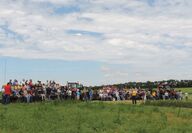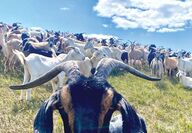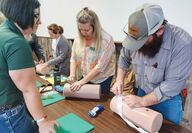Sorted by date Results 10 - 34 of 186
The North Dakota State University Research Extension Centers’ annual field days are set. The events take place at the Research Extension Center sites across the state and feature speakers, tours and field demonstrations for farmers, ranchers, crop advisors, landowners, horticulturalists and local stakeholders. “The agricultural research conducted at our NDSU Research Extension Centers provides research-based solutions that advance agricultural production systems in a variety of areas, including agronomy and crop production, livestock and ran...
The North Dakota State University Research Extension Centers’ annual field days are set. The events take place at the Research Extension Center sites across the state and feature speakers, tours and field demonstrations for farmers, ranchers, crop advisors, landowners, horticulturalists and local stakeholders. “The agricultural research conducted at our NDSU Research Extension Centers provides research-based solutions that advance agricultural production systems in a variety of areas, including agronomy and crop production, livestock and ran...

North Dakota State University Extension has developed a spreadsheet to help farmers analyze and make prevented-planting decisions. "Producers in North Dakota are waiting for fields to dry out so they can start field work and crop planting," says Ron Haugen, NDSU Extension farm management specialist. "If wet conditions continue in certain areas of the state, it will prevent some producers from seeding all their acres before the dates that crop insurance coverage starts to decrease. Now may be a...

The North Dakota State University Research Extension Centers' annual field days are set. The events take place at the Research Extension Center sites across the state and feature speakers, tours and field demonstrations for farmers, ranchers, crop advisors, landowners, horticulturalists and local stakeholders. "The agricultural research conducted at our NDSU Research Extension Centers provides research-based solutions that advance agricultural production systems in a variety of areas, including...

Face flies, horn flies and stable flies are the most common and most treated pests on North Dakota livestock operations. Left uncontrolled, these pests can cause significant loss in livestock production. Fortunately, North Dakota State University Extension specialists say that the proper pest management strategy can provide effective control. While integrated pest management is commonplace for controlling crop pests, similar concepts can apply to controlling livestock pests, according to...

Attending the weeklong National 4-H Conference in Washington, D.C, helped Burleigh County 4-H member Elizabeth Sikes feel more confident in her ability to lead. "The National 4-H Conference was one of my favorite things I have done through 4-H and has helped me further develop my leadership skills," Sikes says. "It was a wonderful experience, and I loved meeting people from all over the U.S. and from different territories." Sikes was one of four North Dakota 4-H'ers who attended the National...

Ranchers depend on grass as a primary source of forage, whether it be rangeland, pasture or hay. While they carefully select species to plant as cover crops or plan a total mixed ration, many ranchers do not know the primary grass species their livestock consume. “Knowing the predominant grass species is important because not all grass is equal,” says Kevin Sedivec, North Dakota State University Extension rangeland management specialist. “Different species have different growth patterns and n...
The warmer winter and early spring have increased the potential for grain storage problems and the need for grain monitoring and management, says Ken Hellevang, North Dakota State University Extension agricultural engineer and grain drying expert. Stored grain temperature increases in parts of a bin in the spring, which is not only due to an increase in outdoor temperatures but also due to solar heat gain on the bin. Solar energy produces more than twice as much heat gain on the south wall of a bin in spring as it does during the summer. That,...

If plants were well established prior to the onset of winter and had the opportunity to harden and tiller, chances of survival are very good, but forage production may be impacted. This year's unusual winter has led to questions for farmers and ranchers who grow forage crops in North Dakota. The lack of snow cover has left winter crops uninsulated from cold temperatures for much of the winter. Recent extreme temperature fluctuations have led to concerns about possible damage to winter annual...

Snow melt, rain and cattle create a recipe for muddy feedlots. While leading to uncomfortable conditions for ranchers, mud is stressful to livestock. Just a few inches of mud requires extra effort for cattle to walk and may lead to a loss of production or weight gain, according to North Dakota State University Extension specialists. As mud depth increases to between 4-8 inches, feed intake can decrease up to 15%. When mud is up to 24 inches deep, feed increase can decrease up to 30%. The...

A juvenile goat in Minnesota recently tested positive for highly pathogenic avian influenza (HPAI). While HPAI has been detected in predatory mammals that prey on infected birds, this is the first identified case of HPAI in domestic livestock in the U.S. The goat lived on the same premises where a poultry flock tested positive for HPAI in late February. The goat shared the same pasture and sole water source as the poultry flock. HPAI is a known disease of wild and domestic poultry and...
In November 2023, the U.S. Court of Appeals for the Eight Circuit issued a ruling overturning the Environmental Protection Agency (EPA)’s final rule of August 2021, which revoked all food crop tolerances for chlorpyrifos. The Eighth Circuit Court’s decision was based in part on the fact that the EPA had issued a Proposed Interim Decision (PID) in 2020, which included 11 chlorpyrifos crop uses that the EPA determined met safety tolerances. Before the PID could be finalized, the U.S. Court of Appeals for the Ninth Circuit issued a ruling ord...

The warmer winter and early spring have increased the potential for grain storage problems and the need for grain monitoring and management, says Ken Hellevang, North Dakota State University Extension agricultural engineer and grain drying expert. Stored grain temperature increases in parts of a bin in the spring, which is not only due to an increase in outdoor temperatures but also due to solar heat gain on the bin. Solar energy produces more than twice as much heat gain on the south wall of a...

Do you want to grow a beautiful yard and garden? North Dakota State University Extension will be broadcasting its Spring Fever Garden Forums online from March 25 to April 15. The live forums will be held on Monday evenings, from 6:30 to 8:30 p.m. CDT and are open to all gardeners. Topics will include how to grow vegetables and fruits, divide perennial flowers, attract pollinators, control weeds, select fast-growing trees, improve garden soil and much more. "This is a great opportunity for...

In November 2023, the U.S. Court of Appeals for the Eight Circuit issued a ruling overturning the Environmental Protection Agency (EPA)'s final rule of August 2021, which revoked all food crop tolerances for chlorpyrifos. The Eighth Circuit Court's decision was based in part on the fact that the EPA had issued a Proposed Interim Decision (PID) in 2020, which included 11 chlorpyrifos crop uses that the EPA determined met safety tolerances. Before the PID could be finalized, the U.S. Court of...

The all sheep and lamb inventory in the U.S. on Jan. 1 totaled 5.03 million head, down 2% from 2023, according to the U.S. Department of Agriculture's National Agricultural Statistics Service. The report indicated a year-over-year decrease of 2% in North Dakota, 3% in Minnesota and 9% in South Dakota. "U.S. lamb consumption was 1.1 lbs. per person per year for 2023, and has room for growth domestically and abroad," says Travis Hoffman, NDSU Extension and UMN Extension sheep specialist. "We have...

North Dakota State University Extension has updated the Crop Compare program, which is a spreadsheet designed to compare cropping alternatives. The Crop Compare program is available online at ndsu.ag/cropcompare. The program uses the direct costs and yields from the 2024 projected crop budgets for nine regions of North Dakota, but producers are encouraged to enter the expected yields and input costs for their farm. The user designates a reference crop and enters its expected market price....

Seconds matter in rural injury incidents or medical emergencies, and the time it takes first responders to travel to an injured person can be critical to survival, says Angie Johnson, North Dakota State University Extension farm and ranch safety coordinator. To help reduce deaths caused by unintentional injury, NDSU Extension and the NDSU School of Nursing have partnered to offer free, Stop the Bleed trainings for residents of rural communities across North Dakota. Nursing faculty have traveled...

This year's warmer and drier winter conditions have created certain benefits for ranchers, such as easier winter feeding and simpler maintenance of water supplies. A major benefit of milder conditions is that cold weather stressors on the cow herd are lower, making it easier to meet cattle nutrient requirements. As helpful as this mild weather has been, there are potential concerns ranchers should be aware of and be prepared for this spring, according to North Dakota State University Extension...

Horse owners and stable managers will have the opportunity to learn management strategies and ask questions during a webinar series that North Dakota State University Extension is hosting at noon CDT on Wednesdays in March. Topics will include an overview of genetic diseases in the quarter horse breed, weed and manure management in pastures, prevention and detection of communicable equine diseases, and emergency first aid until the veterinarian arrives. "The goal of these webinars is to empower...

February is grain bin safety month. North Dakota is no exception when it comes to grain bin entrapments and engulfments. In 2020, North Dakota ranked second in the nation for recorded grain-bin-related entrapments in the Summary of U.S. Agricultural Confined Space-Related Injuries and Fatalities report from Purdue University. That does not account for any undocumented grain bin related injuries and fatalities. Research estimates that 30% of confined spaces incidences, including grain bin...

The meeting will focus on the latest research in canola and will help growers and consultants make sustainable and profitable decisions. Farmers and crop advisers interested in canola production management updates should plan to participate in the 2024 Getting-it-Right in Canola Production virtual meeting on March 12, from 8:30 a.m. to noon. This online-only meeting is conducted by North Dakota State University (NDSU) Extension and is supported by the Northern Canola Growers Association....

The North Dakota State University (NDSU) Extension projected crop budgets for 2024 are available for the state's farmers, says Ron Haugen, NDSU Extension farm management specialist. The 2024 projected profits vary by region and crop. "The budgets are guides for large multi-county regions," says Haugen. "Returns and costs can vary considerably between producers within a region. Also, the budgets estimate returns to labor and management with no consideration of price and yield variability or risk....
The 2023 North Dakota State University Variety Trial Results and Selection Guide for Corn (A793) is now available online and in print. The guide can be accessed online at ndsu.ag/cornvt23. “The corn hybrid guide is a good source of information for farmers and agronomists looking for variety performance data from around the state,” says Clair Keene, NDSU Extension small grains and corn agronomist. “We appreciate our industry partners who participate in these trials and make this work possible.” Printed copies are available through your NDSU Ex...
In the cow-calf production system, reproductive efficiency is the No. 1 driver of profitability. “That’s how this business works,” says James Rogers, North Dakota State University Extension forage crops production specialist. “We market the offspring from our herds. No offspring, no profit.” Rogers references a measure of reproductive performance used in the swine industry called “non-productive days”, or days that a gilt or sow is neither gestating nor lactating. Each non-productive day comes at a cost and serves as a benchmark measure of re...